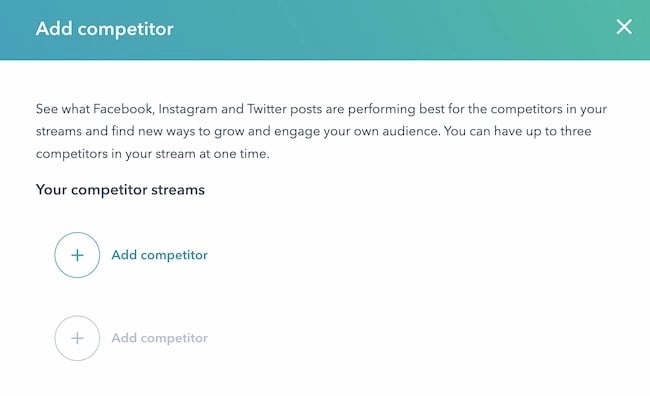[ad_1]
If you want to find the best time to post on Instagram, you’re probably trying to reach a specific goal. Maybe you want to maximize the number of likes you get on each post. Or you hope to improve brand awareness by getting new followers.

If you’re new to social media you might start posting as often as you can and see what happens. But what if you add some scientific thinking to the process? For example, you could try posting at different times of day and jotting down the likes per minute for each post.
That experiment could have value over time, but it’s also pretty intense and time-consuming. Is there an easier way to figure out when to post on Instagram?
In this post, you’ll find everything you need to start posting at the best times on this popular social media platform. Keep reading, or jump to the section you’re looking for with the links below:
What are the best times to post on Instagram?
- According to 2023 HubSpot research, the best time to post on Instagram is from 6PM-8:59PM.
- 8PM in particular is the best time to post for optimal engagement.
- The best day to post is on Friday, followed by Saturday and Wednesday.
- For optimal engagement, the best days are on the weekend, but we recommend paying attention to when your audience is online.
The times above are for Instagram engagement in local time — meaning that your audience is in the same time zone as you are when you post. So, if you live in Los Angeles and your primary audience is also in Los Angeles you would post at the times above. If you live in Los Angeles and your target audience is in New York, you’ll want to shift these posting times three hours forward.
Worst Time to Post on Instagram
According to HubSpot’s 2023 State of Social Media report, the worst time to post on Instagram is between the hours of 6 AM and 8:59 AM.
You can see below that, globally, the lowest Instagram engagement rates are between 6 and 9 AM.
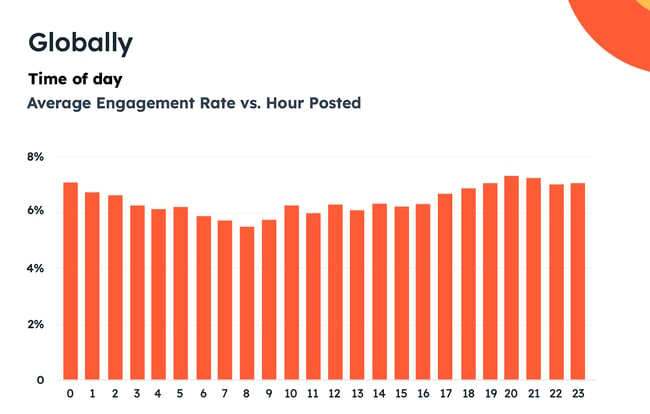
The data remained the same across B2B and B2C verticals. Both B2B and B2C social media marketing managers reported that the worst time to post is between 6 AM and 8:59AM, and that the worst days are Mondays and Tuesdays.
So you can be relieved! There’s no need to wake up early to make that Instagram post. It won’t be much of a problem if you use social media management software to schedule your posts, anyway — but still, it’s nice.
Best Time to Post to Instagram Cheatsheet
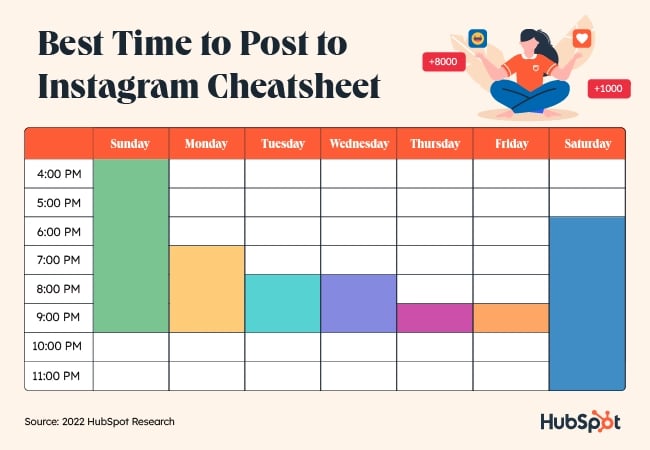
How We Found the Best Instagram Posting Times
This data comes from two sources. First is HubSpot’s 2023 Instagram Engagement report. This extensive report reviewed 110M posts across 1M Instagram users. The report also has several sections specific to English-speaking countries. They analyzed data from close to 85M posts from North America alone.
This post also contains more original research from the HubSpot team. They surveyed 300 professionals from 16+ industries about their preferred days and times to post on Instagram.
Why post on Instagram at a certain time?
According to global Statista data, mobile users spend an average of 12 hours a month on Instagram. That’s about 1% of their time each month, or one in a hundred chances that you will catch your users when they’re on the platform.
So, posting when your top users are online will make a difference. It will give you more time to connect with your most important followers.
But for many marketers, social media posting is just one more thing to do on a busy day. It can be tempting to post whenever it’s convenient or to schedule posts for a time that feels logical, even if there isn’t any data to back it up.
These are a few reasons why it’s important to post to Instagram at specific and consistent times.
Increasing Reach
Some users on Instagram focus their feeds on the friends, businesses, and influencers they already follow. But many others use Instagram for inspiration and discovery. This post from a machine learning engineer outlines some of the factors in helping new users discover your posts.
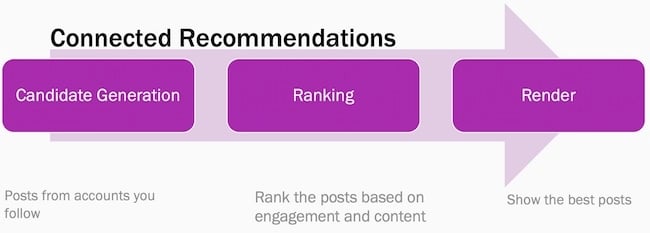
One of those factors is recent engagement. This post from the Instagram blog also outlines how important fresh and recent content is.
So, if you post when your top users are online, your new content is more likely to be one of the first things they see. This can also boost engagement, another ranking factor. This combination increases the chances that new users will discover your account and posts on the platform.
Check out this post for more tips on how to grow your reach on Instagram.
Building a Loyal Audience
Loyalty takes time and effort to build. It’s especially tough for small businesses that have to compete with big brands on social media.
Posting during peak times on Instagram helps you connect with more of your followers at once. It shows your audience that you want to engage with them and keeps your brand top of mind.
It also helps set expectations. Building loyalty is about more than great products and customer service. It’s about being a consistent presence in their feeds that helps you build relationships.
For example, say you run your media business in the Pacific time zone, but a third of your customers are in the Australian Eastern time zone. If you post all your content from 9 a.m-5 p.m. PST, those posts will appear between 3-11 a.m for your Australian customers. Chances are your Australian audience won’t see many posts from your brand.
And what if an unhappy customer in Australia posts a story about your brand? That one post could shape that entire audience’s perception of your brand.
To build a loyal audience, it’s important to understand when your audience is online and to use that information to choose the best time to post.
Increasing Engagement
According to 2023 HubSpot research, the global average Instagram engagement rate is almost 6%. That’s more than the average engagement rate in the previous year.
Instagram engagement creates a ripple effect, like throwing a rock in a still pool. The first ripple is obvious — if you get immediate likes, comments, and saves after posting, it’s more likely that your post will show up in more feeds.
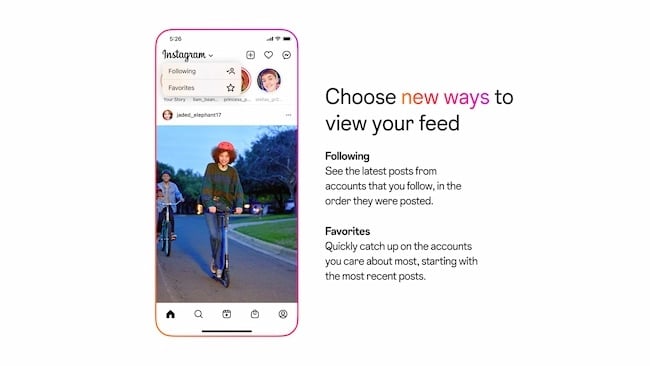
The next ripples come from other Instagram features like Favorites, Search, and videos. Each feature has an independent algorithm. And each feature weighs engagement differently. For example, becoming a favorite for your followers means your posts will show up at the top of their feeds every time they log in. Engagement rates factor into which posts get bumped to the top of Search pages.
So, posting at the right time doesn’t just mean more comments, messages, and saves. It creates more opportunities for engagement too.
Testing New Algorithms
Like most online tools, Instagram launches constant updates to shape the user experience. As a business, your team needs to quickly understand how each update could impact your users and strategy.
Algorithms are complex. Instagram leaders say that each part of the app uses an independent algorithm.
So, one day your latest videos might show up in the feed but not surface on Discover, and it may be tough to figure out why. This can have an immediate impact on your business.
There are a few ways that you can manage these updates. For example, you can keep up with the latest social media news. But the best way to understand the latest algorithm changes is to run tests with your own posts.
So, what do you need to run reliable and useful tests that can help you understand which content your users see after an update? Number one is a consistent posting schedule. The fewer variables your test has, the more trustworthy your results will be.
Better yet, you should post at the best times for your audience on Instagram. This way, you’ll have consistent timing and a wider test group. That strategy can help you get more reliable results.
Understanding New Features
Your posting schedule can also help you understand new Instagram features. Carousels, Stories, and Reels are all unique parts of Instagram. And depending on your content and industry, they’ll each have different rates of engagement.
If your business is investing time and resources into Instagram, it’s important to have a strategy. Strategies usually include different types of content. Whether you want your posts to show up as suggested content or to boost your shoppable stories, you want useful eye-catching content.
When Instagram releases new features, it can take time to understand:
- What the new feature does
- When users see new features
- How they interact with each new feature
- Resources needed for feature content
The sooner you understand a new feature, the more likely it is that you’ll make the most of that feature before your competitors. For example, this post on the Instagram blog tells users how to see more of what they want on their feeds.
Like testing an algorithm update, knowing the top posting times for your niche can help you test new features for your users faster. Social testing is most useful when you know your test audience, which makes posting time important.
Streamlining Your Posting Schedule
Choosing the right times for your audience can make it much easier to schedule your posts. Many social media and marketing managers take advantage of social scheduling tools. While these tools can make the process of social media posting much easier, it can be tough to get results if you’re not posting at the right times.
It’s all about creating the right content at the right time for your audience. And set posting times can also help you create a more personalized social media calendar for your ideal buyer personas.
Here are a few more ways that choosing the best posting times for Instagram can help you simplify your posting schedule:
- Creates focused times for content planning and tracking
- Limits the need for “always on” social media management
- Offers opportunities to batch-create targeted post content
Finding Your Best Customers
While the Instagram app now longer allows users to make purchases directly on the app, it’s still an invaluable lead generation and brand awareness tool — which can ultimately lead to more clicks and purchases.
That’s an incredible incentive to connect with your best customers on Instagram right away. But how can the best posting times help you find prospective shoppers?
You may be new to your industry. If that’s the case, the industry-specific posting times below can help you understand when your users are online. This can help you start seeing from their perspective and you can use those insights to improve your content.
For example, people in financial services are easiest to reach on Instagram on Sunday nights. This is just before the next work week begins. It may be a way to wind down the weekend and prepare for what the next week will bring.
But workers in agriculture are easier to reach on Saturday mornings, and mostly skip Instagram during the week. These professionals might be in spots with limited service during the week. Safety is also a concern, so it may be difficult for them to use mobile devices while on the job.
You can also block out these times on your schedule to engage with users who follow your business. Comment on posts, ask authentic questions, and watch videos from your target audience.
These times are when the biggest pool of your users is active online, so it’s the best time to start a conversation. It’s easy to send a message on Instagram, but not every message gets a response. If you can be there to engage in real time, you’ll get much more value from the time you spend on the platform. You’ll also have a better chance of connecting with top customers.
Is there really a best time to post to Instagram?
It’s clear that posting time matters on Instagram. But is there really a best time to post to get the results you’re looking for? To answer this question, let’s hear from some members of the HubSpot social media team.
Content Quality
It can be tempting to churn out content to meet ambitious deadlines in the hopes that the right customers see your posts. But content quality is what creates the most value for your audience.
Community Management & Growth Specialist Mathew Cruz says,
“It sounds obvious, but making your content as engaging and optimized as possible for the platform it’s being published on is key. “
So, begin each post with the best possible content, then optimize to make sure that followers get to feel the impact of your efforts.
“Start with your target audience, and what types of content and information is most useful to them. What kind of content might they save for later? What might they share with a friend? What might incentivize them to comment on your content? Start with these questions and work backwards in order to improve your reach and performance.”
– Annabelle Nyst, Senior Content Manager, Social Media
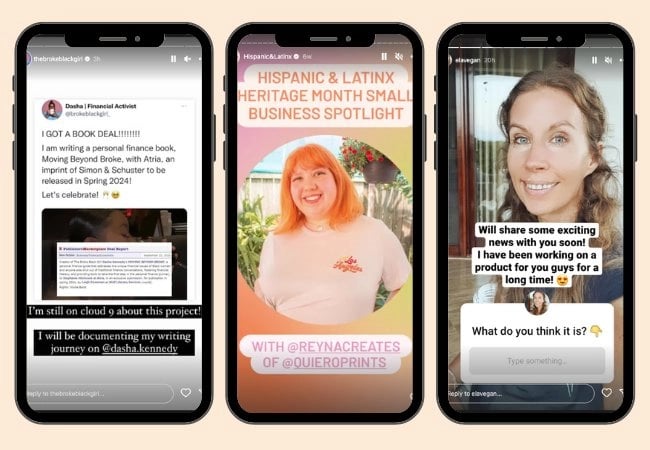
You can also get some inspiration from top influencers and brands on the platform.
Another way to create quality content is to line up with recent trends and news. But this strategy isn’t the right fit for everyone. Here’s more useful advice from Annabelle Nyst:
“When it comes to posting around tentpole moments, events, and trending conversations, you should ask yourself: Does this make sense for my brand to be a part of this conversation? Are we adding value here?”
Instagram’s Algorithm
The best posting time isn’t really about when you post, it’s about when you want users to see your content. But that’s up to the algorithms that are unique to each part of Instagram.
So, the care you put into posting time is only one part of a more complex system that delivers your content to people on the platform.
According to Mathew Cruz: “Instagram’s algorithm and UX changes have made an impact on the effectiveness of posting at specific times. Unless your users are consuming their content in the “following” view, the time your audience will see your content can vary.”
To optimize the chances that people will see and engage with your content, check out these tips:
“Look at what the Instagram algorithm appears to be prioritizing at any given moment – for example, Reels. We know that Instagram has been leaning into Reels as a format in order to compete with TikTok, so how can you incorporate Reels into your strategy?
The more you adhere to what Instagram wants to see, the more the algorithm will favor you. Also, always optimize for value and engagement first.” – Annabelle Nyst
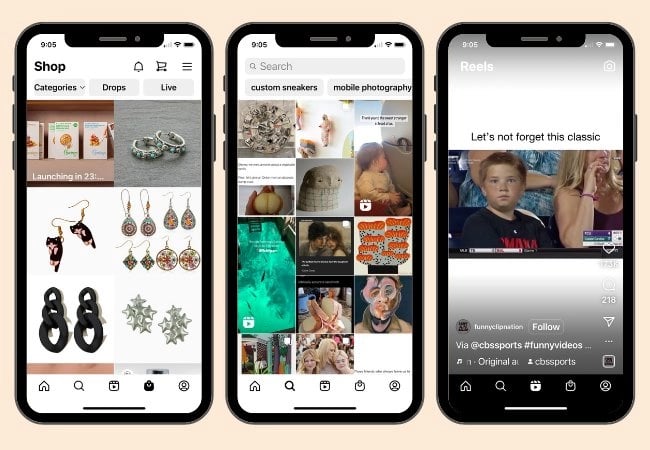
“With Instagram, understanding the UX and algorithm changes can be more effective in strategizing content publishing rather than simply timing.
For example, with Instagram’s shift to pushing video over images, the types of content you choose to create and publish may impact the chances of it being pushed out to users.
Additionally, feeding the algorithm with what your content is about helps it know where it should go. For example, adding relevant captions, hashtags, and sounds can help increase chances of it appearing on the feeds of users that enjoy specific types of content.” – Mathew Cruz
Content Consistency
Social Strategist Erin McCool says: “Quality and consistency of content is more important than timing.”
Consistency is key to taking advantage of social media opportunities. Whether you’re amplifying your stories at the same time each week or posting with branded hashtags, a steady schedule is essential.
If you don’t have a clear brand voice on Instagram, it won’t help you to reach more audience members. Without consistency, it’s unlikely that users will recognize and connect your content to your brand no matter how many times they see it.
So, don’t just post at the best times. Use the best times to post as a guide for a consistent posting schedule. This strategy can help you reach the right audience at the right time with the right content.
Best Time to Post on Instagram by Time Zone
Your location can heavily influence the success of your social media marketing strategy. Audiences behave differently depending on where they are in the world, and you can benefit from knowing when they’re most active on Instagram.
You know that evenings tend to be the best time to post to Instagram for engagement. But how do you make that happen if your audience lives in multiple time zones?
This is where you need to make some decisions about the best posting times on Instagram for your audience. To help you make these choices, here’s more compelling data from the 2023 Instagram Engagement report.
North America
According to HubSpot research, the best time to post on Instagram in North America is between 6 to 9 PM, as those were the hours with the highest engagement. It’s no surprise: People tend to be winding down in the evenings, and as such, they usually access their Instagram apps at around this time.
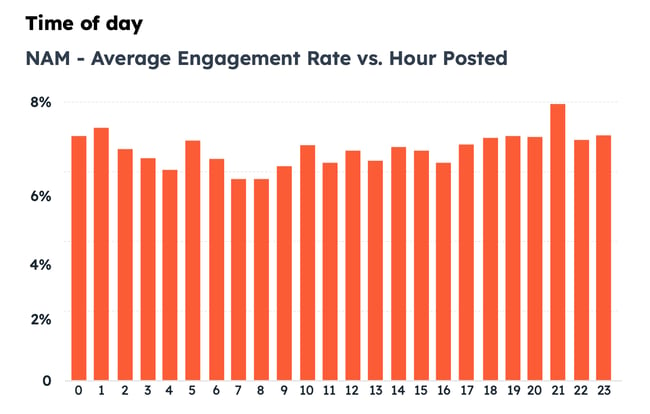 As you can see, though, the engagement rate is between 7% to 8% for most hours — you really can’t go wrong with your posting time, so long as you make an effort to study your audience and learn when they’re specifically online.
As you can see, though, the engagement rate is between 7% to 8% for most hours — you really can’t go wrong with your posting time, so long as you make an effort to study your audience and learn when they’re specifically online.
The hours you might want to specifically avoid are between 6 and 9 AM.
UK and Ireland
In the UK and Ireland, the best time to post is from 10 PM to 2 AM to generate high engagement. Yep! That’s quite late, so even if you work during UK and Ireland hours, you’ll want to use a social media tool to schedule your posts well ahead of time — unless you’re willing to log in at 1 AM to post.
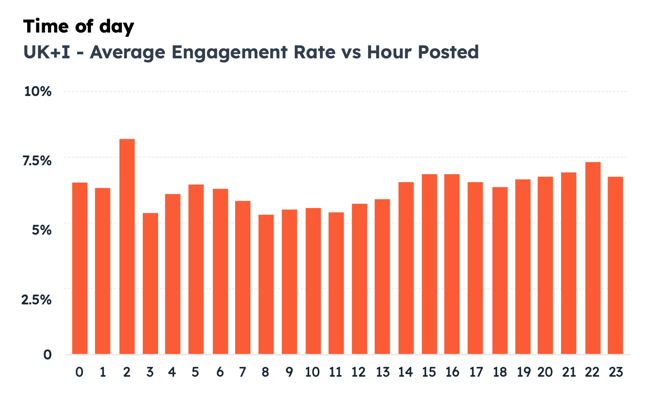
You’ll want to avoid the morning hours from 9 AM to 11 AM.
Asia-Pacific
In Asia-Pacific, the best time to post on Instagram is between 7 and 9 PM. During our research in this region, we saw huge peaks in engagement at those hours.

APAC engagement rates are more volatile. You’ll specifically want to avoid posting between 5 and 7 AM, as those were the times with the lowest engagement.
Best Time Each Day to Post on Instagram
Every day of the week is a good day to post on Instagram, but you’re likely to get the best engagement on weekends.
The chart below shows the average engagement of each day of the week. As you can see, even though weekends are when you’ll see the most engagements, the data is pretty steady throughout the week.
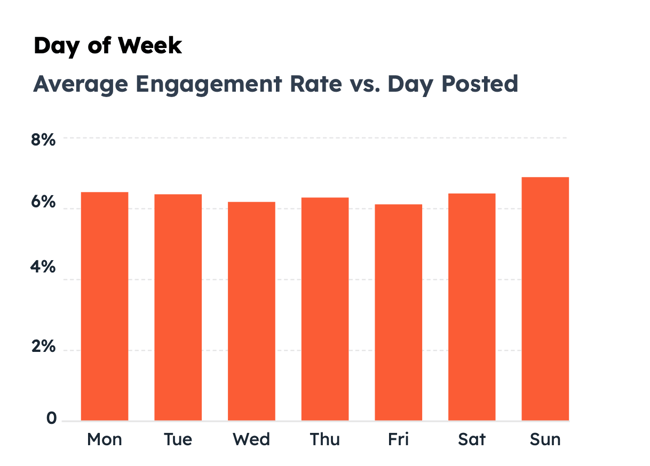
This means that you’ll want to do deeper research to figure out which days are best for you to post. This is where industry-specific data can help.
For example, if your followers work at a desk job with regular hours, they might be taking a lunch break around noon. This would mean that they could be more likely to scroll through Instagram during that time to catch up on the latest from their friends, favorite brands, and influencers.
But what if they work in an industry with a less consistent schedule? For example, real estate agents often work around their clients’ schedules, showing homes on the weekend or after work hours.
This means that their scrolling time will be different from other users. You’ll want to track their behavior or use industry benchmarks to find the best day to post.
Best Time to Post on Instagram by Industry
General data about optimal post timing is a great starting point. But if you want to get more granular, HubSpot research surveyed over 300 professionals to help you engage with your top audience. Here are the best times to post on Instagram for over 16 popular industries.
Education
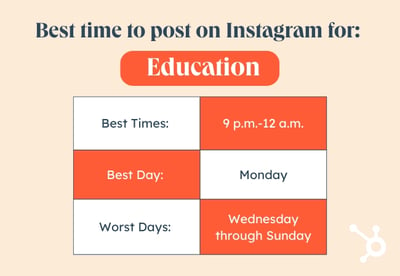
Best Times: 9 p.m.-12 a.m.
Best Day: Monday
Worst Days: Wednesday through Sunday
If you work in the education sector, the best time to post is from 9 PM to 12 AM, specifically on Monday. That may be because educators are preparing for the week at this time and may be more receptive to content from education brands.
Healthcare Companies
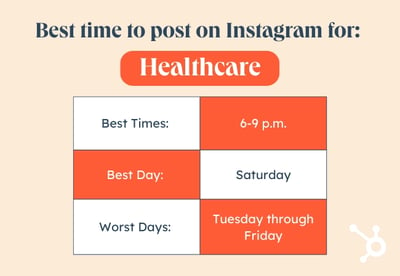
Best Times: 6-9 p.m.
Best Day: Saturday
Worst Days: Tuesday through Friday
For healthcare companies, the best time to post on Instagram is in the evenings, from 6 PM to 9 PM, and specifically on Saturday. You’ll want to avoid posting on Tuesdays through Fridays.
Financial Services
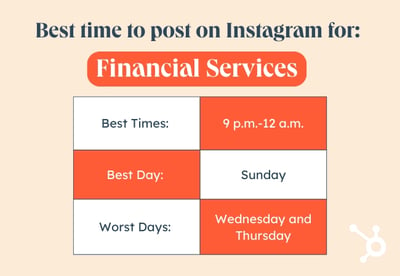
Best Times: 9 p.m.-12 a.m.
Best Day: Sunday
Worst Days: Wednesday and Thursday
Financial services companies will want to post from 9 PM and 12 AM — remember, a social media tool can help you schedule late-night posts! — and Sundays are one of the best-performing days in terms of engagement.
Retail

Best Times: 3-6 p.m.
Best Day: Sunday
Worst Day: Tuesday
Retail companies should consider posting between 3 PM and 6 PM on weekends, especially on Sundays. Tuesdays were the worst day according to our research.
Ecommerce
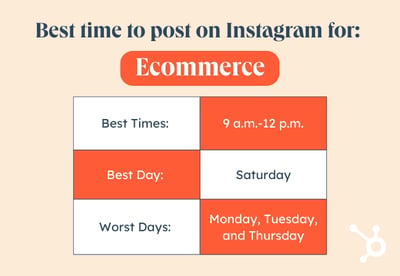
Best Times: 9 p.m.-12 a.m.
Best Day: Saturday
Worst Days: Monday, Tuesday, and Thursday
Ecommerce brands would benefit from posting between 9 PM to 12 AM, in keeping with the general pattern that evenings perform best for most brands. Saturdays were the best days to post on Instagram, while you’ll want to avoid Mondays, Tuesdays, and Thursdays.
Business Services
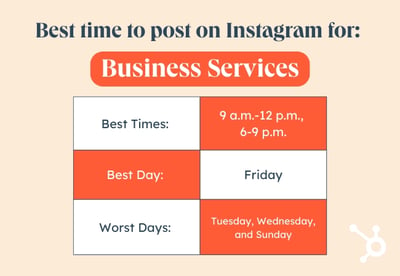
Best Times: 9 a.m.-12 p.m., 6-9 p.m.
Best Day: Friday
Worst Days: Tuesday, Wednesday, and Sunday
Companies that offer business services would do well to post on Instagram between 9 AM and 12 PM — the starting hours of most people’s business days. Evenings between 6 and 9 PM also performed well. The best day to post, surprisingly, is on Friday.
Consumer Manufacturing
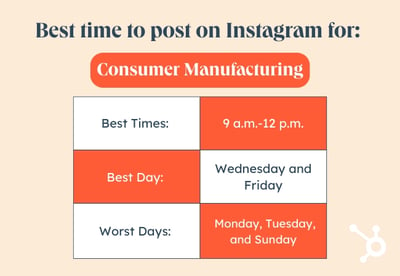
Best Times: 9 a.m.-12 p.m.
Best Days: Wednesday and Friday
Worst Days: Monday, Tuesday, and Sunday
Consumer manufacturing organizations should post on Instagram in the mornings, between 9 AM and 12 PM. The best days to post are Wednesdays and Fridays.
Manufacturing and Materials
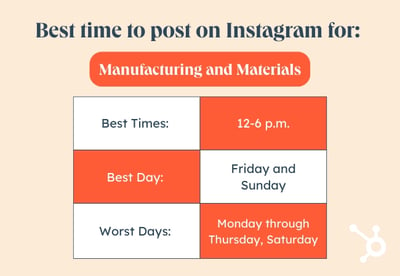
Best Times: 12-6 p.m.
Best Day: Friday and Sunday
Worst Days: Monday through Thursday, Saturday
Companies in the manufacturing industry should post in the afternoons between 12 PM and 6 PM, starting with most businesses’ lunch breaks. The best days are Fridays and Sundays.
Construction Companies
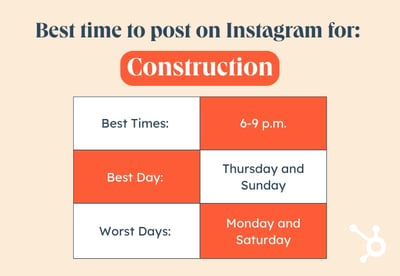
Best Times: 6-9 p.m.
Best Days: Thursday and Sunday
Worst Days: Monday and Saturday
Like most verticals, construction companies would benefit from posting in the evenings between 6 and 9 PM. Thursdays and Sundays are the best days.
Agricultural Organizations
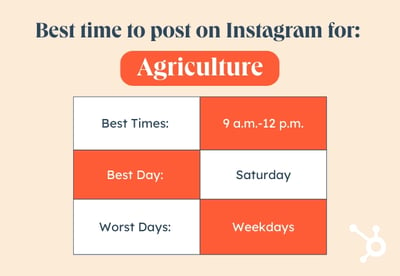
Best Times: 9 a.m.-12 p.m.
Best Day: Saturday
Worst Days: Weekdays
The best time to post on Instagram for agricultural organizations is in the morning, between the hours of 9 AM and 12 PM. You will want to avoid weekdays and post on weekends, specifically on Saturday.
Electronics Organizations
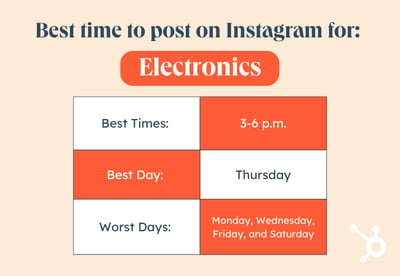
Best Times: 3-6 p.m.
Best Day: Thursday
Worst Days: Monday, Wednesday, Friday, and Saturday
Electronics organizations would benefit from posting in the afternoons, between 3 PM and 6 PM. The best day to post is on Thursday.
Energy, Utilities, and Waste Management

Best Times: 6-9 p.m.
Best Day: Saturday
Worst Days: Sunday through Friday
Energy, utilities, and waste management organizations would benefit from posting between 6 and 9 PM. The best day to post is on Saturday, while our research respondents reported that every other day is a poor option.
Information Technology
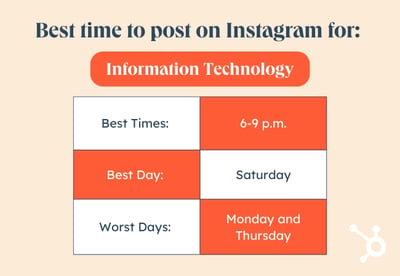
Best Times: 6-9 p.m.
Best Day: Saturday
Worst Days: Monday and Thursday
Like most businesses, IT companies should post in the after-work hours, between 6 and 9 PM. The best day to post is on Saturday, but remember to experiment to find out what works for your audience.
Media and Entertainment
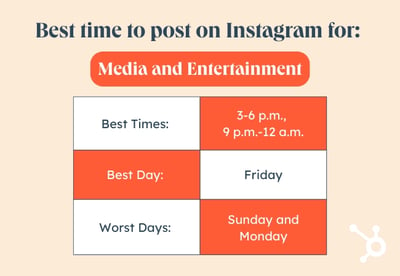
Best Times: 3-6 p.m., 9 p.m.-12 a.m.
Best Day: Friday
Worst Days: Sunday and Monday
The best times to post on Instagram for media and entertainment companies are between the hours of 3 PM and 6 PM, and 9 PM and 12 AM. The best day to post is on Friday.
Transportation and Logistics
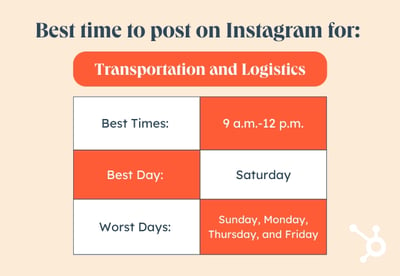
Best Times: 9 a.m.-12 p.m.
Best Day: Saturday
Worst Days: Sunday, Monday, Thursday, and Friday
Transportation and logistics companies would benefit from posting in the morning, between 9 AM and 12 PM. Our respondents reported that Saturday was the best day to post.
Advertising and Marketing Organizations
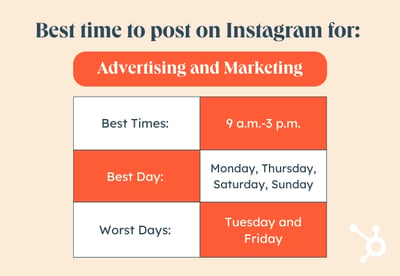
Best Times: 9 a.m.-3 p.m.
Best Days: Monday, Thursday, Saturday, Sunday
Worst Days: Tuesday and Friday
Advertising and marketing organizations have countless options for posting on Instagram. The best time to post is during the work day from 9 AM to 3 PM, and the best days include Mondays, Thursdays, Saturdays, and Sundays. You’ll want to avoid Tuesdays and Fridays.
Remember that the guidelines above are just that — guidelines. It’s essential to constantly gauge your engagement rates to find the best times to post for your specific audience. We recommend using the above data as a starting point, then adjusting slightly as time goes on.
Best Time to Post Different Instagram Content Types
What about the different types of Instagram content? What is the best time to publish them and get a good engagement rate? Let’s take a look.
Best Time to Post Reels on Instagram
We recommend following the general guidelines. The best time to post Instagram Reels is in the evening between 6 and 9 PM, when engagement rates increase globally.
That said, you can’t go wrong with posting Reels, because they’re so popular. Instagram CEO Adam Mosseri actively shares Instagram updates on Twitter, and many of his recent posts highlight new Reels features and emphasize the importance of this post type.
Trusted resources offer the same tips for the best time to post Reels as they do for other types of content, such as videos and photos, on Instagram. You’ll want to post when your users are online, and that means carefully taking a look at your engagement rates.
The top tip for Reels timing: Be sure to post consistently. If the uploading days or times you post are sporadic, the algorithm won’t prioritize your account visibility.
Best Time to Post Instagram Videos
The best time to post Instagram videos is between the hours of 6 and 9 PM.
Best Time to Post Instagram Stories
The best time to post Instagram Stories is between the hours of 6 and 9 PM. If you work in the B2B sector, you could also benefit from posting an Instagram Story at lunch time (from 11 AM to 1 PM), where your business audience might be scrolling through their app. That said, global average engagement rates peak in the evenings.
Best Time to Go Live on Instagram
The best time to go live on Instagram is in the evening, when users are unwinding for the day and have the time to watch a live broadcast.
Best Time to Post Instagram Carousels
The best time to post Instagram carousels and photos is between the hours of 6 and 9 PM.
How to Find the Right Time to Post to Instagram for Reach
Data on the best posting times for Instagram is incredibly useful. That said, it’s often most effective when you’re just starting out.
As you continue to develop your presence on the platform, you might want to boost your results and do some posting time research on your own. The tips below are useful places to start.
1. Use a Social Media Tool
The most effective way to find the best posting time on Instagram is to use a social media tool, which will allow you to post at different times without needing to log into Instagram each time. Social media software is useful not only because you won’t need to remember to log in to Instagram — you can simply schedule your posts — but because you can test and experiment with more exactitude.
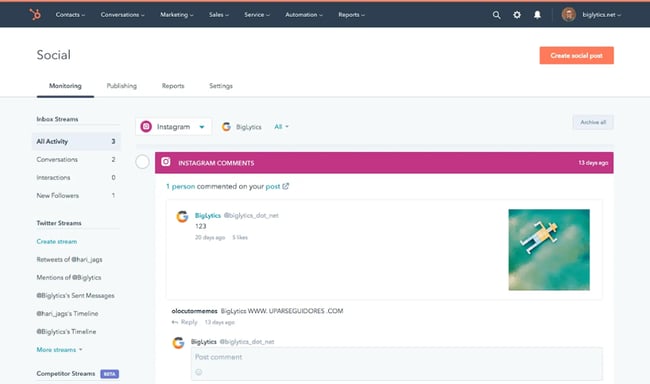 Try HubSpot’s social media tool for free!
Try HubSpot’s social media tool for free!
Plus, you can see your posting history through reports — there’s no need to go through your Instagram posts one-by-one.
2. Experiment with Posting Times
To find the best time to post for your brand, it’s essential to experiment. Our 2023 data strongly suggests that posting in the evening hours from 6 to 9 PM is a great place to start. Then, test out another time — such as lunch time or midafternoon — and see if that changes engagement rates for your posts.
Try to keep the type of posts you make consistent. For instance, test out posting times for Reels specifically, with similar caption lengths and subject matter. That way, the only variable is the posting time itself, and not any other characteristic.
3. Check Your Top Posts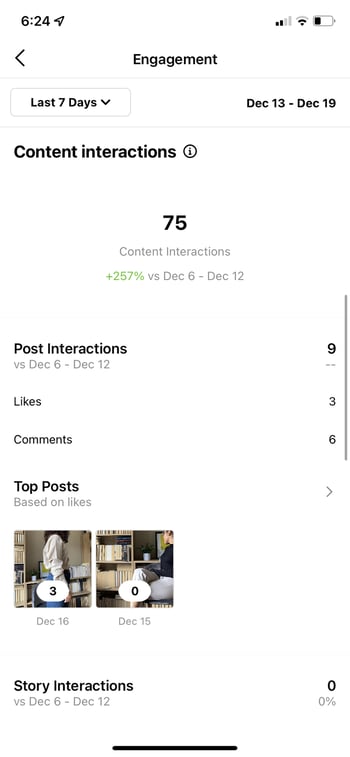
Tracking your top posts can help you understand what posts are most popular and which topics draw the most engagement. It can also help you see how posting time impacts those factors.
For example, is that recent post about company events the most exciting content for an online beauty company? Or did it generate the most likes last month because it was posted on Saturday evening, a top time for ecommerce engagement?
You can use Instagram Insights to check out your top-performing posts, as well as factors like:
- Engaged audience
- Total followers
- Most active times
HubSpot customers: You can check the Top Posts report for a quick list of your top ten posts. You can also check interactions, clicks, shares, and impressions for each post.
As you start to look at your social analytics, it can be tempting to focus on the numbers. But when you’re looking at top posts, it’s important to stick with your creative side and to look at your numbers from your customer’s point of view. As you check your top posts, ask yourself:
- What is special about this post?
- What kind of content is it?
- If it’s a video, what makes this video stand out?
- If it’s a photograph, how is this photo different from the others you’ve posted?
- Did you edit the post?
- Did you add text or design elements to the post?
- Is there something that ties the people who’ve liked this post together?
- Does this post connect to a current trend or event?
You may want to gather top post insights for a few months before you dig into analyzing your post content. This can help you see the top content your users respond to and when they want to see that type of content.
4. Track Competitor Posting Times
Another way to choose the right time to post for your audience is to figure out who else has their attention. Starting with your top competitors helps you figure out when to post and what content works on different days and times. Competitive analysis can also help you:
- Learn about trends and benchmarks in your niche
- Update your social strategy
- Pinpoint new opportunities
There are a few ways to begin this research.
First, just scrolling through Instagram can give you a wealth of competitor insights. Take a look at a brand’s likes, hashtag copy, and how many hashtags they use. This can give you a quick profile of who follows that brand and what keywords they use, so it can hint at that competitor’s strategy.
If you want to do more detailed research, there are many great tools to help you track your competition. For example, you can create competitor streams with HubSpot’s social media software.
Try HubSpot’s social media tool for free!
With this feature, you can track multiple competitors at once and filter your results by social network or time period.
5. Focus On Engagement
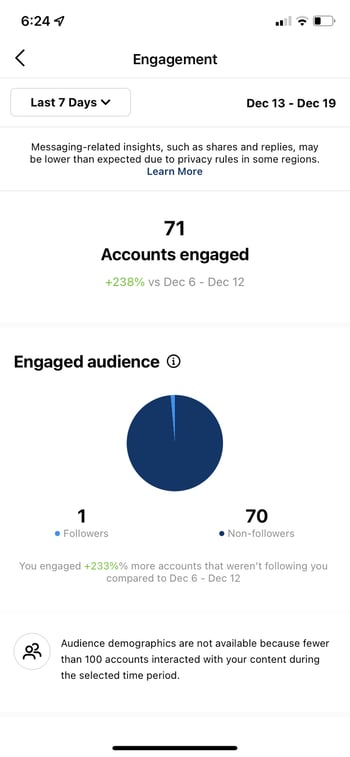
Strong engagement on Instagram is between 1-5%. According to HubSpot research, the average engagement in 2021 was 5.86%. The average engagement rate for 2020 was just 2.26%, so these rates can change quickly.
If you want to improve engagement, start by calculating your Instagram engagement rate. You can measure your rate with your all-time numbers, but it can be helpful to break this data into smaller sections, like months or weeks. That way you can see engagement patterns for your account over time. It can also make it easier to see how the times you post on Instagram could impact your engagement rate.
Engagement rates show how people are reacting to your content. So, whether you’re sharing Reels, going live on Stories, or posting polls, questions, and quizzes, you can measure your impact. Engagement rates can sway based on:
- Audience interest
- Relevance
- Social authority
It’s also important to remember that your most engaging content may not be as sticky at the same hours each day. Some content takes time to pick up views and shares before it makes an impact during peak engagement hours. Other content is like a firework — exploding quickly and disappearing just as fast.
To optimize your post timing for engagement, you need to get organized. The best way to find an ideal posting time is by testing the timing of your posts to see which post time generates the most audience engagement.
For example, what if you want to figure out when you get the most likes and comments on your Instagram carousels?
Say you create and post five different carousels a week and post them at random times. That approach will make it tough to get data that shows you the best times to post carousels for engagement.
But what if you post five similar carousels at a slightly different time each day? Then you can compare your engagement rates with the time you posted each carousel. This can show you the best time to post carousels for engagement so you can plan future carousels with those times in mind.
6. Use Your Data
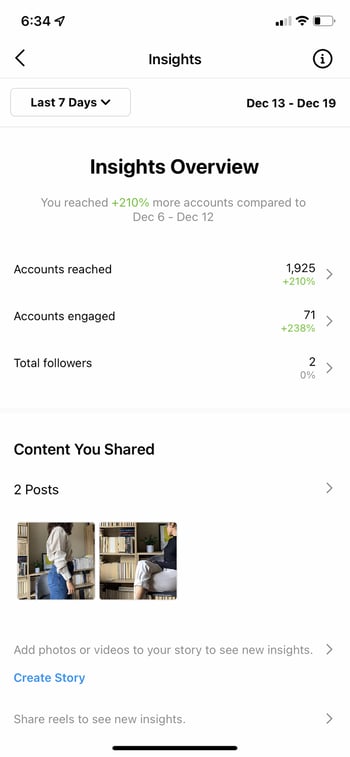
When you’re new to Instagram, follower and engagement numbers are often low. Numbers for posting time, content type, hashtags, and more can be so similar that you may not spot the patterns that can help you grow.
Social media analytics can make these patterns easier to see and experiment with.
For example, the audience section in Instagram Insights can show you the days and hours when your followers are active. You can use that information to create a posting schedule. This can help you see whether posting during peak hours improves your reach.
At the same time, it’s important to remember that anyone with an account has access to Instagram Insights. And according to HubSpot research, 52% of Instagram accounts have 1,000-10,000 followers.
So, there’s a good chance that other brands are showing up in your followers’ feeds during that active time. You may want to post outside of active hours to see if your account draws more attention when there’s less competition.
It’s great to have the best times on Instagram available when planning your strategy. But tracking your own data can give you the personalized insights you need to stand out.
Boost Instagram Engagement on Your Schedule
Organic Instagram engagement and a consistent posting schedule go hand in hand. Each industry has natural peaks and valleys of activity each day. This means that your Instagram strategy should flow with them. Use helpful resources, like this cheat sheet, to plan your social media calendar and watch your engagement rate soar.
Editor’s note: This post was originally published in February 2021 and has been updated for comprehensiveness.
[ad_2]
Source link


![New Data: Instagram Engagement Report [Free Download]](https://no-cache.hubspot.com/cta/default/53/9294dd33-9827-4b39-8fc2-b7fbece7fdb9.png)
